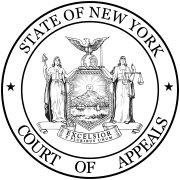| Braschi v. Stahl Associates Co. | |
|---|---|
 | |
| Court | New York Court of Appeals |
| Full case name | Miguel Braschi, Appellant, v. Stahl Associates Company, Respondent. |
| Decided | July 6, 1989 |
| Citations | 543 N.E.2d 49; 74 NY.2d 201; 544 N.Y.S.2d 784 |
| Court membership | |
| Judges sitting | Sol Wachtler,[a] Richard D. Simons, Judith S. Kaye, Fritz W. Alexander II, Vito J. Titone, Stewart F. Hancock Jr., Joseph W. Bellacosa |
| Case opinions | |
| Decision by | Titone |
| Concurrence | Kaye, Alexander, Bellacosa |
| Dissent | Simons, Hancock |
| Keywords | |
Braschi v. Stahl Associates Co. was a 1989 New York Court of Appeals case that decided that the surviving partner of a same-sex relationship counted as "family" under New York law and was thus able to continue living in a rent controlled apartment belonging to the deceased partner.[1]
The litigant, Miguel Braschi, had been in a long-term relationship and lived with his partner Leslie Blanchard, who rented an apartment on East 54th Street in Manhattan.[2] Blanchard had died of AIDS in 1986—Braschi had been a dutiful caregiver during his partner's illness and a loving partner of over ten years.[3]
Under Section 2204.6(d) of New York state's Rent and Eviction Regulations, eviction of a "surviving spouse or family members" is prohibited. Braschi argued that this applied to his relationship with his deceased partner.[2] The Appellate Division court rejected this and argued that "homosexuals cannot yet legally marry or enter into legally recognized relationships", and that the Rent and Eviction Regulations were intended to provide protection to those in "traditional, legally recognized familial relationships".[2]
In a subsequent appeal, the New York Court of Appeals found that a "more realistic, and certainly equally valid, view of a family includes two adult lifetime partners whose relationship is long term and characterized by an emotional and financial commitment and interdependence". Application of this standard allowed Braschi to be considered a family member and prevented his eviction from the apartment.[4] The decision was the first time a court in the United States granted any kind of legal recognition to a same-sex couple.[5]
Cite error: There are <ref group=lower-alpha> tags or {{efn}} templates on this page, but the references will not show without a {{reflist|group=lower-alpha}} template or {{notelist}} template (see the help page).
- ^ Braschi v. Stahl Associates Co., 543 N.E.2d 49 (N.Y. 1989).
- ^ a b c "We Are Family?". ABA Journal. American Bar Association: 96. November 1, 1988. ISSN 0747-0088.
- ^ Panel on Monitoring the Social Impact of the AIDS Epidemic; National Research Council; Division of Behavioral and Social Sciences and Education (January 1, 1993). The Social Impact of AIDS in the United States. Commission on Behavioral and Social Sciences and Education. National Academies Press. p. 247. ISBN 978-0-309-04628-2.
- ^ Mark Philip Strasser (1997). Legally Wed: Same-sex Marriage and the Constitution. Cornell University Press. p. 17. ISBN 0-8014-8429-4.
- ^ Robert Wintemute; Mads Tønnesson Andenæs (2001). Legal Recognition of Same-sex Partnerships: A Study of National, European and International Law. Hart Publishing. pp. 139–140. ISBN 978-1-84113-138-2.